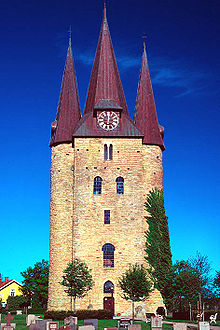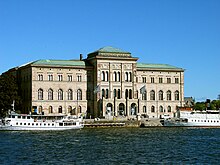Swedish architecture
This article describes the historical development of Swedish architecture .
middle Ages
The Swedish Middle Ages lasted about 500 years, from Olof Skötkonung's baptism around 1000 to Gustav Wasa's rise to power in the 1520s. In the beginning almost all buildings in the city and in the country were made of wood. In the 12th century, however, hewn stone became the building material for monasteries and churches in the Romanesque style . Lund , Sigtuna , Husaby and Alvastra bear witness to this architecture. In the country, the small Romanesque churches were often built as fortified churches .
With the Gothic , brick came to Sweden as a new building material. The domes in Västerås , Strängnäs and Uppsala were built of brick, while the domes in Skara and Linköping were built of limestone.
While around 1500 of the 4000 Swedish churches date from the Middle Ages, little of the secular buildings has survived from this period; some town houses in Stockholm and Visby as well as remains of fortresses and castles. The city wall around Visby from the 13th century is one of the best preserved medieval city walls in Europe. The street network of the old town in Stockholm is also still medieval.
Renaissance
With the takeover of power by Gustav Vasa and the Reformation , the conditions changed radically. The church building almost stopped completely. The nobility hardly built either. At this time, the great Wasaburgs were built, which were built in strategically important places to rule the country, but at the same time should also accommodate the roaming courtyard. Gripsholm Castle , Kalmar Castle and Vadstena Castle impress with their massive walls, but also with the merging of medieval architecture with elements of the Renaissance that was conveyed through Germany and Holland .
Baroque
With Sweden's rise to a great power in the 17th century, the high nobility began to build. At the same time, the profession of the architect emerged, whose reputation is closely related to the builders Simon de la Vallée and Nicodemus Tessin the Elder. Ä. solidified. Numerous city palaces and country castles were built based on Western European, especially French, models. But also the building of churches was resumed, and the Katarina Church in Stockholm became the model for many church buildings in the empire. With Nicodemus Tessin the Elder J. the high baroque makes its entrance, such as B. in his main work, the Stockholm Palace or in Kalmar Cathedral .
A number of cities were also founded in the 17th century. Their layout followed a regular, chessboard-like floor plan with a central square. There are only deviations in Skåne, then Danish, and in Gothenburg , which was built with canals in 1619 based on the Dutch model. The floor plan is still recognizable in these cities today, even if the buildings, mostly made of wood, have disappeared.
Classicism and Empire style
In the second half of the 18th century, especially after the coup d'état of Gustav III. there was a reorientation based on ancient models. In 1773 the building school of the art academy was founded and a little later an office for the supervision of the building industry was set up. Both raised the quality of the architecture, but at the same time weakened the regional building traditions. The palace theater in Gripsholm, the Botanikum in Uppsala and the grammar school in Härnosand are examples of the new classical ideals in architecture .
After the Napoleonic Wars and the loss of Finland , state construction activity concentrated primarily on the military sector. The Karlsborg Fortress and the Gota Canal , were working on the year's 23-in construction to 60,000, the largest Swedish construction projects ever were. The leading architect of the first half of the 19th century was also a military man, Colonel Fredrik Blom , who, in addition to a number of barracks, also built the classicist Skeppsholm Church in Stockholm and - as the king's house architect - the Rosendal Empire palace .
historicism
The industrialization of Sweden began in the second half of the 19th century . The population of the cities tripled in a few decades. The rapid urbanization led to hectic construction activity: tenements, but also public buildings such as schools, hospitals, prisons, hotels, banks, market halls, theaters and churches were built. A historicist eclecticism shaped many of the buildings. The German August Stüler received the prestigious contract to build the National Museum , for which he went back to the Renaissance, Fredrik Wilhelm Scholander's Synagogue in Stockholm is inspired by Assyrian architecture, his student Helgo Zettervall is mainly involved in the extensive renovations / conversions of the cathedral in Uppsala , Skara and Linköping , expressing his interpretation of Gothic. Johan Fredrik Åbom , the most productive architect of his time, designed numerous churches as well as a number of town houses in the spirit of the neo-renaissance, which also characterizes one of his main works: Berns Salonger with restaurant and stages, an expression of a new bourgeois attitude towards life, immortalized in Strindberg's novel Das Rote Room .
National romanticism and art nouveau
Towards the end of the 19th and the beginning of the 20th century, a new generation of architects appeared in public who turned against historicism and classicism. On the one hand, they took on influences from abroad, such as B. the Art Nouveau , which was realized in the Royal Dramatic Theater ( Dramaten ) in Stockholm, on the other hand they looked for models in the Swedish cultural history and the Swedish building traditions. From this search for a national architecture, the Swedish national romanticism arose , which combined these Swedish models with ideas from the English arts and craft movement to create an often very personal architecture in wood and brick. Carl Westman's House of Doctors' Association in Stockholm is one of the first buildings in this style. Röhsska museet in Gothenburg and Stockholms rådhus are two other examples of Westman. But the most outstanding building in the national romantic style is Stockholms stadshus by Ragnar Östberg , which was built between 1903 and 1923 .
Gustaf Wickman devoted himself to a very unique task , who within 3 decades built an entire city in an uninhabited wilderness: Kiruna . After finding rich deposits of iron ore there and building a railway line, Wickman was entrusted with building the town. Within a few years the mansions of the director and the engineers, workers' apartments, offices, schools, a hospital, a fire station, post office and bank, swimming pool etc. were built. a. His main work, however, is the church in the national romantic style, which combines American timber architecture with influences from Norwegian stave churches and Sami huts.
Modern and post-modern
Modernism was initiated by a group of architects who followed the austerity of classicism. Gunnar Asplund is one of the most famous representatives. The highlights of his work include Lister's District Court in Sölvesborg , the Stockholm City Library and the Skogskyrkogården cemetery , which was created together with Sigurd Lewerentz and is now a World Heritage Site.
The Stockholm Exhibition of Industry, Crafts and Handicrafts in 1930 helped functionalism to break through in Sweden, which in the years to come - especially in residential construction - became an almost official ideology. A typical example of the strong connection between functionalism and popular political movements is the Kvarnholmen district in Nacka , which was designed in the 1930s by the architectural office of the consumer cooperative, founded in 1924 as the first collectively organized architectural office.
Despite these missions, the standard of living in Sweden was extremely low. After the Second World War , major construction projects began to overcome the housing shortage and raise living standards, which culminated in the government's million-dollar program in the mid-1960s , namely the construction of 1 million new apartments within 10 years (one Population of 7.8 million). Not only were entire dormitory cities (or districts in smaller cities) pounded out of the ground in a short time, many city centers were also razed to make way for modern, functionally planned shopping and office centers. The huge construction projects were planned and managed by newly created large architectural offices, whereby the quality often had to give way to mass production.

With the oil crisis in 1973 , the million program came to an end. Even before that, critical voices had been raised against the schematic mass architecture and the negative social consequences that these mass buildings entailed.
The term postmodernism emerged from this criticism and encompasses a number of different tendencies. In Sweden a wealth of forms developed that had not existed since national romanticism. One of the most important representatives of postmodernism in Sweden is Ralph Erskine .








